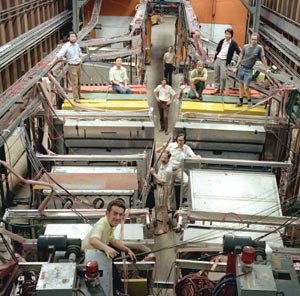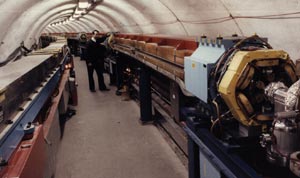The physics of B particles, containing the fifth (b) quark, is now a major research focus. The first such particle was discovered at Fermilab exactly 25 years ago.

A quarter of a century ago, particle physicists were accustomed to making a major discovery more or less every year. Some of the greatest drama was provided by the highly unexpected announcement of the J/psi particle in 1974 – the “November Revolution”. After the initial amazement had died down, physicists learned that nature contained a fourth “charm” quark that augmented the traditional up-down-strange triplet.
However, even before this discovery, Makoto Kobayashi and Toshihide Maskawa had pointed out that more than four quarks were possible. To explain the mysterious violation of CP symmetry, they had suggested that six types of quark could be present. And so it came to be.
But in 1974, many physicists had trouble digesting a fourth quark, and initially paid little attention to a call for any more. In the newly extended four-quark picture, the charm quark was paired with the strange quark to form a second doublet, a heavier counterpart of the up-down pair which make up the protons and neutrons of stable nuclear matter. These two quark doublets could also be associated with two then-known electrically charged weakly interacting particles (leptons), the muon and the electron. The muon, being heavy, went with the heavier charm-strange quark pair, while the electron was associated with the lighter doublet.
Then, in the mid-1970s, a group led by Martin Perl working at the SPEAR electron-positron collider at the Stanford Linear Accelerator Center (SLAC) discovered a third electrically charged lepton, the tau, which was much heavier than the muon. It took time for the idea to be accepted, but a third charged lepton called for a third doublet of quarks, making the sextet suggested by Kobayashi and Maskawa.
Talk of heavier quarks became commonplace, and the shadowy third doublet was called either “top” and “bottom” (reflecting the “up” and “down” of everyday quarks) or “truth” and “beauty” by the more romantic. (The “top” label has now eclipsed “truth”, but “beauty” and “bottom” are both widely used. In either case the labels of the third quark doublet can be abbreviated to “t” and “b”.)

The first awareness that leptons could be served in different ways had come with Lederman, Schwartz and Steinberger’s 1962 neutrino beam experiment at Brookhaven, which showed that neutrinos (electrically neutral leptons) come in two kinds – one associated with electrons, the other with muons. (Describing this discovery in the March 1963 issue of Scientific American, Lederman wrote: “These days, the discovery of a new elementary particle is scarcely news…”)
Neutrino beams became a new physics tool, and one idea was to use them to uncover the W and Z carrier particles of the weak force, which are analogous to the photon carrier of electromagnetism. The signature of a W, the charged carrier of the weak force, would then be a pair of oppositely charged leptons (electrons or muons). This search soon bypassed the need for a neutrino beam altogether, and focused instead on the production of charged lepton pairs at high energy.
The upsilon
The W was not found via this route, but in the late 1960s Lederman’s team at Brookhaven uncovered a bump in the spectrum of muon pairs. The reason for this mysterious effect was not immediately clear, but Lederman’s curiosity was aroused. Physicists had learned that charged lepton pairs (either muons or electrons) could be a pointer to other photon-like particles, created in the annihilation of quarks and antiquarks deep inside subnuclear processes.
In this way, Sam Ting codiscovered the J/psi particle at Brookhaven in 1974. This, with a parallel experiment by Burt Richter at SLAC’s SPEAR ring, catalysed the November revolution. The J/psi is a tightly bound charmed quark-antiquark pair.
Having missed out on the J/psi discovery, which earned a Nobel prize for Richter and Ting, Lederman diligently continued his study of muon pairs, this time in a new energy domain using the Fermilab synchrotron. An initial sighting near 6 GeV triggered a discovery action plan, with the Greek letter upsilon being reserved for a possible new particle. This signal went away, but in 1977, muon pairs began to accumulate at 9.5 GeV. This time it was a new particle.
The upsilons (on close examination, there were several of them) are b quark-antiquark pairs, in the same way that the J/psi is made up of a charmed quark and antiquark. Unlike the J/psi, the upsilon was not discovered via the electron-positron annihilation route, as in 1977 no electron-positron collider had enough energy. Nearest in energy was the DORIS machine at DESY, Hamburg, and following the upsilon news the DORIS beam energy was turbocharged in a crash programme. By the following summer, the PLUTO and DASP detectors at DORIS had seen their first upsilons.

The lightest upsilons are tightly bound and therefore cannot decay into their component b quarks. The next collider to arrive on the B physics scene was Cornell’s CESR electron-positron collider, which came into operation in 1979, and with its higher energy could reveal a full array of upsilon resonances. By the following year, the CLEO and CUSB detectors at CESR were seeing the first B particles (containing the b quark) produced via the decay of the heaviest (4S) upsilon.
For the next few years, these detectors, together with the ARGUS detector at DORIS, were major players in B physics, which went on to become mainstream science at major machines all over the world. In a major effort, the spectroscopy of B particles took shape, and the parameters of the b quark were documented.
In the 1970s, the economical SPEAR electron-positron collider at SLAC showed how effective these machines could be. Bigger colliders – PETRA and PEP – were proposed at DESY and SLAC, respectively. Even bigger was the TRISTAN machine at the Japanese KEK laboratory. Unfortunately, the energy ranges covered by these machines were not as rich in discovery potential as SPEAR’s had been.
B-factories
The next chapter in the B physics saga is being written by a pair of new high-intensity machines which mass-produce B particles – PEP-II at SLAC and KEKB at KEK. Proposed in the mid-1990s, these machines are now making their first precision measurements, and provide the right conditions to explore CP violation in a new setting – B physics. The wheel has turned full circle – after providing the first indication that a third generation of quarks exists, CP violation is now being measured using those quarks.
Eclipsed by the new B-factories after making a decade of milestone contributions, notably with a line of CLEO detectors, the CESR machine at Cornell stopped for B physics in 2001. The physics of b quarks is far from being fully understood, and major mysteries remain. For the future, B physics will continue to be a major focus, notably at Fermilab’s Tevatron collider and with the LHCb detector at CERN’s LHC collider. (The “top” or t quark, the companion of the b quark in the third quark doublet, and the heaviest quark of all, was discovered at Fermilab in 1995, giving that laboratory a proprietary interest in the heaviest quark pair.)
Further information
Twenty years
The 20th anniversary of B physics in 1997 was marked by a symposium at the Illinois Institute of Technology in Chicago, US. The proceedings of this meeting, edited by Ray Burnstein, Daniel Kaplan and Howard Rubin, and published in the American Institute of Physics Conference Proceedings Series (Volume 424), provide a valuable pointer to early developments in B physics. Its title – “Twenty Beautiful Years of Bottom Physics” – underlines the continuing confusion about what to call the fifth (b) quark.








